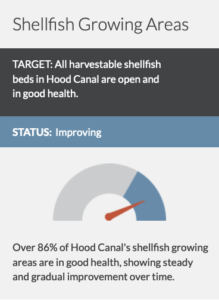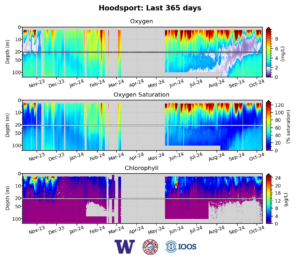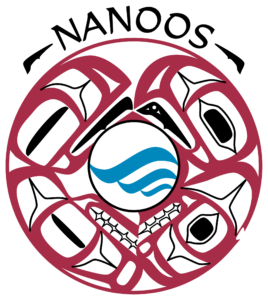Major fish kill on Hood Canal highlights importance of fishing closure
WDFW, Oct 13, 2003
Hood Canal’s waterways connect us and define the region. The Canal is never far from view, and collects all the surface runoff, with everything we put into it, from the streams and rivers throughout the watershed. Where freshwater meets saltwater, estuaries remind us of our communities’ reliance on the natural environment. Humans and shellfish alike thrive in clean water and support the nearshore ecosystem essential for growing salmon and the beaches we love for swimming, fishing, and harvesting.
Water that enters the Canal stays for a long time, which makes pollution prevention urgent. The dangerous mix of surface inputs (excess nutrients and bacteria), and minimal mixing of the water column, can degrade water conditions and result in beach and shellfish bed closures, and at its most extreme, marine species mortality.
Improving and protecting water quality is a high priority of HCCC’s, and is vital for maintaining a healthy Hood Canal. Our water quality activities include:
Hood Canal Regional Pollution Identification & Correction Program
 The Hood Canal Regional Pollution Identification and Correction (HCRPIC) Program works collaboratively with the region’s water quality authorities and partners to protect and restore water quality by preventing bacterial and nutrient pollution from human and animal waste that threatens public health, our ecosystem, economy.
The Hood Canal Regional Pollution Identification and Correction (HCRPIC) Program works collaboratively with the region’s water quality authorities and partners to protect and restore water quality by preventing bacterial and nutrient pollution from human and animal waste that threatens public health, our ecosystem, economy.
The Hood Canal watershed includes approximately 30,000 onsite septic systems (OSS), many in close proximity to water bodies. As these systems age, they can degrade and leak pollutants into the watershed, which eventually make their way to the nearshore environment. The HCRPIC Program monitors for these leakages at the shoreline, and investigates up the drainage to find and correct the source. This work is essential to maintain and improve water quality by reducing bacterial and nutrient pollution sources.
View upcoming HCRPIC Program meeting information and recent documents below. Visit the Calendar and Library for reports and more resources.
12-YEARS OF COLLABORATION
View the HCRPIC Program StoryMap below summarizing the program’s successes over its 12 years of regional collaboration. Full size StoryMap available here.
The Hood Canal Aquatic Rehabilitation Zone was established by the WA State Legislature in 2005 in response to numerous “fish kill” events due to degraded water quality that caused very low dissolved oxygen conditions in Hood Canal’s marine waters. As the Local Management Board for the Hood Canal Aquatic Rehabilitation Program (RCW 90.88), HCCC worked with local partners and researchers with the University of Washington and the Hood Canal Dissolved Oxygen Program to respond to this urgent call for action.
Learn more about the Hood Canal Dissolved Oxygen Program (HCDOP). 
The Washington State Legislature established the Hood Canal Aquatic Rehabilitation Program in 2005, designating the HCCC as the local management board to coordinate local government efforts for addressing the low dissolved oxygen problem in Hood Canal.
The HCCC Board of Directors established the Hood Canal Aquatic Rehabilitation Technical Advisory Committee (TAC) to advise and assist HCCC Board members in their deliberations and development of management actions to address low dissolved oxygen. The TAC analyzed scientific data and findings and evaluated management and policy actions for the HCCC Board’s consideration.
The TAC Workgroups developed next steps for low dissolved oxygen actions and worked to advance the development of the Hood Canal Regional Pollution Identification and Correction Program and the Hood Canal Regional Stormwater Retrofit Plan.
This role was instrumental in advancing HCCC’s ecosystem recovery work across the organization – the development of the Hood Canal Integration Watershed Plan, Hood Canal Regional PIC Program, Stormwater Retrofit Plan, and the Hood Canal In-Lieu Fee Mitigation Program.
Two decades later, water quality throughout the Canal and our understanding of dissolved oxygen issues have improved significantly. The threat of hypoxic conditions will always remain from the natural conditions of the Canal itself, but we can mitigate those conditions by reducing the human-caused pollution inputs from surface water runoff that can tip the scales – if the water and weather conditions are just right – to form a deadly combination for another fish kill event.
View current marine water quality conditions in Hood Canal from ORCA buoys at Dabob Bay, Twanoh, and Hoodsport.



View additional regional data through the NANOOS Data Explorer.
HCCC worked with our partners and the Hood Canal community to identify, prioritize, and plan for the retrofit of high priority stormwater infrastructure to improve water quality and stream flows.
Visit the Library to view plan documents, including the regional stormwater retrofit plan goals and criteria, priority site evaluations, and maps.
The Hood Canal Regional Stormwater Retrofit Plan is designed to coordinate stormwater and low impact development (LID) retrofit efforts on a watershed (Action Area) scale using common prioritization and planning strategies to maximize benefits, efficiency, and consistency.
The plan identifies, prioritizes, and plans for retrofit of high priority stormwater infrastructure to provide important environmental and public health benefits, limit runoff and pollution of surface waters and increase infiltration of rainwater in the Hood Canal watershed. It prioritizes retrofits in locations that are most important to the protection or restoration of watershed processes and achieves the following objectives:
